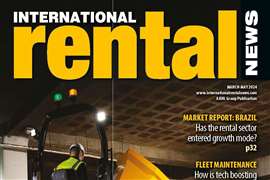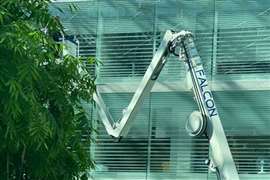Web exclusive: Extended interview with Sandvik Construction’s Dinggui Gao
25 February 2014
.gif)
Appointed in May last year, Dinggui Gao is now a few months into his new role as president of Sandvik Construction. A little unusually for the construction equipment industry, he comes from another sector, having most recently worked as truck manufacturer Man Group’s representative at its Chinese joint venture, Sinotruck. He has also held various positions with Honeywell, Eagle Ottawa and Bosch.
And when iC met Mr Gao at Sandvik Construction’s head office in Stockholm, his enthusiasm for the new role was clear. “It has been very exciting for me. I have been able to visit quite a few customers and been to all of our sites,” he said.
Notwithstanding Mr Gao’s enthusiasm, there is no getting away from the fact that Sandvik Construction has had a tough time over the last few quarters, as have most construction equipment manufacturers. Its sales last year were down -11.2% on 2012 at SEK 8.6 billion (US$ 1.32 billion), it barely squeaked into the black with an operating profit of SEK 110 million (US$ 17 million) and the order intake was down -6.5% to SEK 8.51 billion (US$ 1.3 billion).
According to Mr Gao, the primary reason for this was the economic environment. “On one side, the performance was impacted by the market,” he said, “The global market was slow last year. China, India and the US were slower than before and the financial crisis has continued in this industry. Europe has suffered a lot and consequently we have taken more of an impact, and that is why we need to rationalise.”
But he also said that the company could have been more nimble in adapting to changing conditions. “We are also looking at areas where we could have done better in terms of our internal processes. We have been doing that for several years, but the speed at which we have done that and taken cost out has not been as severe as the market downturn, so there has been a bit of an imbalance. So we really need to be proactive as a business.
“We need to keep an eye on the trends and take actions in advance. We need to do a better job in terms of having a plan, forecasting what is coming and taking actions ahead of that,” said Mr Gao.
As Mr Gao alluded, one of the issues for Sandvik Construction is that it relies very heavily on European markets. Despite the depressed state of this region, it still accounted for some 40% of revenues and orders in the fourth quarter of last year. But Europe only accounts for about 20% of global construction activity.
The need for some geographic rebalancing at Sandvik Construction is one Mr Gao acknowledges. “We still very much rely on Europe. That is where the company started. But if you look at where the growth is coming from, it is not Europe any more. Europe has stabilised, but the growth is coming from the US, China and South America,” he said.
But the need to get more deeply into emerging markets will have far-reaching consequences, not only in terms of the company’s footprint, but also what it produces. “If we want to grow and stay competitive, we need to refocus on where the growth is, and that will mean that in five or ten years our portfolio will be completely different.
“You really need to be a step ahead. Think about what’s happening in the next five years or ten years and make the preparations for that, rather than just passively follow and losing that competitive edge,” said Mr Gao.
Warming to the theme he added, “We need to follow these trends. When our customers go international, we need to follow them. If we are selling equipment to a Chinese contractor, the chance is that they will take it to Africa.
“The global economy today is built much more on international trade and knowledge exchange between companies. We need to be in sync with that, or one step ahead. If you can see what is going to happen, you can be better prepared for it.”
That need to go where the growth is means the company’s footprint is likely to change. What’s more, this is all tied up in a wider project across the Sandvik group to manufacture in, and source from places where it can get the best value for money.
“One thing’s for sure – there’s going to be change,” said Mr Gao. “We’re going to change according to the markets and what we produce. It doesn’t make sense to make machines in Sweden and transport them all the way to China. But it doesn’t make sense to make big castings in China and then ship them all the way to Sweden.”
So although some sort of shift of production and supply base to emerging markets seems likely, Mr Gao said it was not a foregone conclusion. “We always emphasise the best-cost-country or region,” he said, “Our manufacturing footprint will be located in the most competitive places and will be located to be most convenient for our customers. Those are the criteria we’re using to revaluate our supply chain.
“The end result will most likely be countries like China, India, Brazil, Eastern Europe, but the starting point is the countries that are most competitive. So if other regions are competitive we will use them. We will not just move to emerging markets for the sake of it.”
He added, “If you’re a customer you don’t care too much about where the product comes from as long as it fulfils your demands, it is of good quality and comes with really good service. How we do that is our job.”
Part of this move to capture more business in emerging markets has been the launch over the last few years of Sandvik’s ‘Basic’ range – reliable, quality equipment with no frills. It is an area where Mr Gao sees further growth.
“In the past few years, Sandvik has done a fantastic job in strengthening our competence in what we call the mid-market – markets like China, India, Brazil, Africa, the Middle East and to a certain extent, parts of Europe. We launched about 20 products last year in the mid-market alone, so that means the accumulated effort of the last few years is showing some results, and we can address the demands of the mid-market.
“We also have a partner in China, a joint venture called Shanbao, and covers a different segment to the Sandvik brand. We have broadened our offering to the mid-market and we are looking for other opportunities. We have a very good foundation to grow in that segment.
“Interestingly, as we grow in the mid-market, we are finding sales are not coming from China and India and places like that alone. Even in mature markets like Europe and the US, there are segments of the business that require different designs of products. An example would be recycling of demolition waste. That segment does not require a machine to run 24 hours a day, seven days a week. The key requirement there is for something that is smaller and easy to transport from one site to another,” he said.
So what does this all mean for the company’s development and how it serves its customers over the coming years?
“My ambition is that in three to five years, this business will grow much more efficient and much closer to its customers, with much more innovation in the market.
“Starting with the customers, I think we can probably better link with our customers and identify other opportunities.
“From the process perspective, I would like to see a much more competitive manufacturing and supply chain footprint, and much more efficient processes in terms of converting ideas into finished products. I would like to see much better service for our customers.
“On the product side, I would like to see products much better suited to different markets.
“With our people, I would like to see more global talent, with capabilities spread around the world more, and we will continue to be the leader in the niches we occupy,” said Mr Gao.
Ready for the upturn?
But the immediate future of Sandvik Construction is about putting the difficulties of 2013 behind it and being ready for the market recovery. It has not materialised yet, but Mr Gao said there were a few promising signs.
“We have seen at least a stabilisation towards the end of last year. In quarter four last year we saw good development in some pockets of the industry. I’m not saying there was a recovery, but signs of some better demand from the markets.
“We are keeping a close eye on things of course. There have been some warning signs in January, which might be due to the seasonality of the industry – the severe winter in the US and the Chinese New Year, for example – but we are cautiously optimistic,” he said.
One of the problems with the construction equipment industry is that it sees such big cyclical swings that when demand does pick up, it is difficult for manufacturers to ramp-up production. They need to add staff and they also need a flow of components from their suppliers. It can make for long waiting times for customers.
It is a potential problem Mr Gao acknowledges. “There will surely be some surprises when the up-turn comes,” he said. “Any industry that is cyclical will see that, even though everyone knows they have to be prepared
“We are dealing with thousands of partners, from suppliers and sub-suppliers to dealers and customers. Even if 99% of those are prepared for an up-turn, there is 1% that isn’t and you are going to get a blow-up at some point. So we are planning and preparing for that, but I cannot exclude the possibility of problems when the trend reverses.
“When you have a downturn and you are trying to de-stock, that affects the whole value chain and the severity to your suppliers is magnified. We have suppliers who sell to multiple equipment manufacturers, so if we deal with a 5% or 10% fluctuation at the front line, it will magnify to 50% for our suppliers and sub-suppliers in a short period of time. So how do you increase capacity by 50% when the upturn comes?
“That is a question you need an answer to, especially as many of our suppliers and sub-suppliers are small and medium-sized companies, which don’t necessarily have the mechanisms to ramp-up that quickly. So it is a concern, and we are trying to do a better job.”







